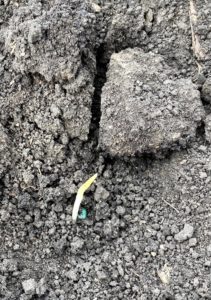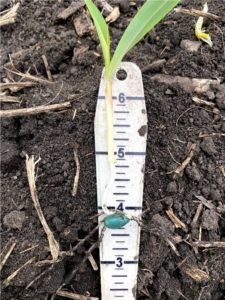Your Local Weekly Ag Partners Agronomic Update.
The one-stop-shop to hearing everything you need to know this week about what is happening in your fields.
This week’s featured agronomists are:
Jake Heitshusen- Le Sueur
Erin Stackhouse- Owatonna
Noah Erickson – Lake City
Zach Thompson- Lewiston
Chace Kinneman- Ellsworth
Scroll down to hear from your local agronomist.
West
Belle Plaine – LeCenter – LeSueur
|
Jake Heitshusen |
Corn is starting to pop up here to the west. We have been dry for the last 2 weeks with some spotty rain. A good widespread half inch would help activate a lot of pre emerge chemicals laying on top of the ground. With corn being mostly in stages VE to V1, now is a great time to get out and check on how well our planters performed, as well as seedling heath and expectations for the year. Here are a few things to look out for as we have seen some themes start to appear in the last week or so: |
This field was planted on April 30th , 3 days after a half inch of slow rain. Conditions seemed dry on top but as we can see, we can still identify the furrow the disc opener made at planting. In this case, we were fortunate that it didn’t seem very hard and some rain helped break it up. Most of the plants look to be in good condition with nice white mesocotyles and roots with firm seeds.
Overall this field looks to have lost around 2k plants per acre to slow emergence and imbibitional chilling It had a planted population of 36k and a final stand around 33k. This loss wouldn’t require any replanting. The forecast is calling for some moisture and heat, which we are in need of and should help get everything going and keep us on track for a great year! If you would like some help scouting your corn stands, give your local Ag Partners Agronomist a call and we would be glad to help you!
Central
Wanamingo – Kenyon – Morristown – Owatonna
|
Erin Goebel |
We are finally getting needed rain in our area and hope it continues through the rest of the week. For the next couple of weeks, we will be performing stand counts on corn and grading emergence. This year is going to be a year you really need to keep an eye on emergence, as the seed is having a difficult time coming out of the ground with the dry conditions. Rachel (Owatonna’s Summer Intern) and I were able to fly a couple of fields with the drone and do stand counts the past few days. The corn is still a little small for stand counts from the air but we did see some interesting things. |
This field was planted on April 9th, 2021. The green circles represent a corn plant, and the red circles represent a missing corn plant. It will be interesting to fly this field after these rain showers and the heat that will follow this weekend, to see if those corn plants can make it out of the ground. This area in the field came back as 70% emerged.
To perform stand counts, we utilize a Phantom 4 drone with Sony technology on it (pictured below).
South
Lewiston
|
Zach Thompson |
It’s has been an interesting week in our trade area! The soybean planting is pretty well wrapped up, giving guys time to go out and check their corn emergence. We have been across several acres and have made the recommendation for the rotary hoe and even replants in certain areas. We had a rain event that came through and dumped 2” in a short amount of time. Now is a great time to evaluate seedling vigor ratings. |
Let’s take a minute and think about what we have put that seed through so far this year. Planting conditions were excellent. however there was large variation in moisture. The seed that was planted into moisture took on the moisture and began to germinate, while other seed sat in dry dirt. The next issue is the temperature fluctuations. Depending on your weather source there were only five days in the last month that the temperature was above 70 degrees, with plenty of frosty mornings. That seed has been through a lot of stress trying to get out of the ground this year from what Mother Nature has given us. The rainfall has been very spotty in the last week. Looking forward the temperatures look to be above 70 with chances of rain all week. Get in touch with your Agronomist with any questions. You will most likely see us soon, since it is a great time to be out digging seed.
East
Pine Island – Cannon Falls -Goodhue -Lake City
|
Noah Erickson |
Assessing Hail Damaged Alfalfa Fields This last weekend some of us experienced a smaller thunderstorm that produced varying amounts of rain and hail. With that being said, how do you go about assessing your alfalfa fields that sustained some damages due to the hail? Being a week or two away from taking first crop, the biggest question is if the correct answer is to cut or not to cut if your crop was damaged? |
There are different variables that you have to look at when it is a new seeding versus an established stand.
If you receive hail on your new seeding, the first step is to see if the plants have developed crowns or not.
- If they do not have crowns and have damage done to their terminal buds, then the plants will die.
- If not all are affected, make sure your stand still has at least 25 plants/square foot to keep a sufficient stand. Seedlings with developed crowns and are over 6 inches tall, will more than likely put out new shoots and survive.
- Assessing affected established stands is a little different. Damage will occur in different ranges of severity, ranging from the terminal buds (top part of the plant) and leaf damage to plants that are completely defoliated.
- Alfalfa plants grow from their highest portions of the plant, which is the terminal part of the plant. If these are damaged by hail, this will cause the plant to terminate its top growth and then requires it to begin new shoots at the base for regrowth.
(Damaged terminal buds on alfalfa plant)
Below are the recommendations for making a management decision to a damaged established alfalfa field.
- If the alfalfa field is within two weeks of harvest, you will want to wait 3 to 4 days to allow the stand to recover and harvest.
- If the field is within two weeks of harvest but has less than 50% of its terminal buds damaged, you will want to allow the stands to mature to your normal harvest schedule to harvest. Your yield will still be reduced but undamaged plants will continue to grow to its full potential yield and will produce additional yield.
- If the alfalfa is within two weeks of harvest but has more than 50% of its terminal buds damaged, you will want to harvest immediately because there will be minimal additional growth. With the assumption the terminal buds have been destroyed.
- If the field stand is not within two weeks of harvest, wait for the new shoot regrowth and harvest at normal harvest height.
(Summary of recommendations when assessing damaged alfalfa stands)
If you have had any impacted fields and concerns with making the management decision on your own, consult your Ag Partners agronomist to help make the best decision with you.
WWAS
Ellsworth
|
Chace Kinneman |
Hope everyone is doing well! Corn and beans are starting to poke through in our area and we are finally starting to get some well needed rain! Overall, the corn emergence looks pretty good but I have been seeing some uneven stands due to it being so cold and dry. Early sidedress is on the horizon with some guys already going. |
Uneven corn emergence due to early spring dry, cool temperatures. These corn plants were dug out of the same row and they were 3 consecutive plants.
I’ve had a few calls about if the Sonic will work with no rain. With no rain, sonic is still roughly 75% effective and it will not photodegrade. The pre-emerge will sit there until it gets enough rain to activate it. Overall it has been doing a good job this year, however there are a few giant ragweed that have blown through the chemical application. Be sure you are paying close attention to the weed control in your fields and spray early, because Giant Ragweed gets really hard to kill once it get s to 4 to 6 inches tall.
Giant Ragweed coming in soybeans.



















